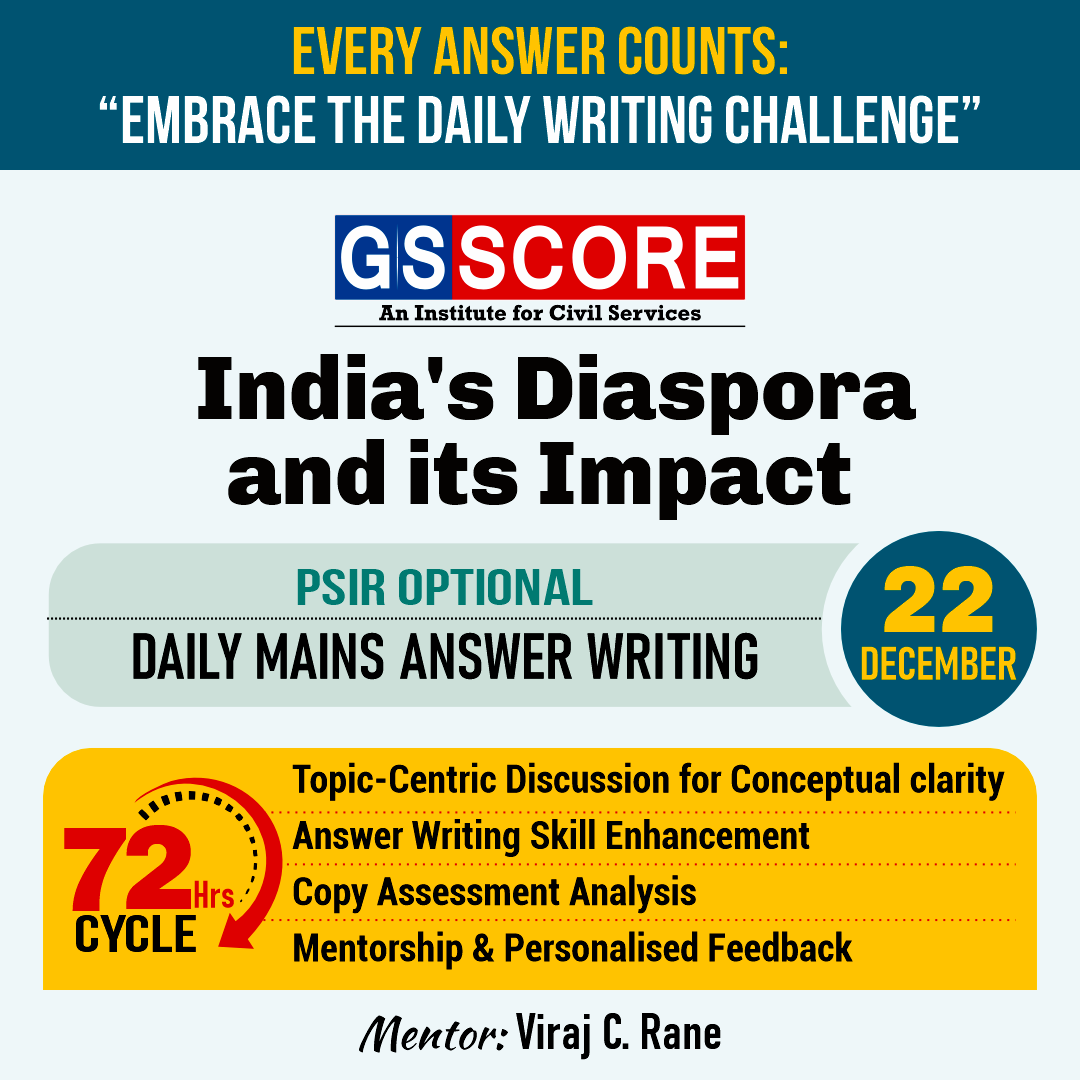


Instruction:
- There will be 2 questions carrying the First Question is-10 marks Write your answers in 150 words and the Second Question is-15 marks Write your answers in 250 words.
- Any page left blank in the answer-book must be crossed out clearly.
- Evaluated Copy will be re-uploaded on the same thread after 2 days of uploading the copy.
- Discussion of the question and one to one answer improvement session of evaluated copies will be conducted through Google Meet with concerned faculty. You will be informed via mail or SMS for the discussion.
Question #1. Evaluate the role played by the Indian Diaspora in providing a platform for a stronger relationship between India and ASEAN countries. 10 marks (150 words)
Question #2. The Indian diaspora spread throughout the world is the most robust and influential strategic asset in the hands of Indian policy makers today. Comment with examples. Also, highlight the engagement of India with Diaspora in recent times. 15 marks (250 words)
(Examiner will pay special attention to the candidate's grasp of his/her material, its relevance to the subject chosen, and to his/ her ability to think constructively and to present his/her ideas concisely, logically and effectively).
STEPS & INSTRUCTIONS for uploading the answers
Step 1 - The Question for the day is provided below these instructions. It will be available at 7:00 AM.
Step 2 - Uploading of Answers : Write the answer in A4 Sheet leaving proper margins for comments and feedback and upload the PDF in MY ACCOUNT section. Click on the option of SUBMIT COPY to upload the PDF.
Step 3 - Deadline for Uploading Answers: The students shall upload their answers by 7:00 PM in the evening same day. The first 50 copies will be evaluated.
Step 4 - Feedback : Mentors will give their feedback for the answers uploaded. For more personalised feedback, join our telegram channel by clicking on the link https://t.me/mains_answer_writing_cse . A one-to-one session will be conducted with the faculty after copy evaluation in 72 Hrs.
Model Answer
Question #1. Evaluate the role played by the Indian Diaspora in providing a platform for a stronger relationship between India and ASEAN countries. 10 marks (150 words)
Approach
- Contextual Introduction of the India's Civilization Relation with the Southeast Asia.
- Role and significance of Indian Diaspora in strengthening relationship between India and ASEAN countries.
- Highlight challenges and suggest measures in this regard
- Conclusion
Hints:
A proverb in ancient India was very popular among Gujrati traders about Java: “those who go to Java or the East never returns, but if he returns, his decedents live at ease for generations.” Today, this proverb seems to be true from the fact that India’s civilization and culture spread in many parts of the world through trade but struck firm roots in Southeast Asia. Through the centuries, India has been a source of inspiration for countries belonging to the present-day ASEAN. In Cambodia, Thailand, and Indonesia or Burma today, many symbolic remnants of India’s influence are clearly visible in their art, culture, and civilization.
The relationship still with the Government of India’s ‘Act East policy’ aims at improving economic and political relations with the Southeast Asian region which has had close contact with India for centuries and is linked culturally and geographically with it. Moreover, India’s dialogue partnership with ASEAN has evolved into a strategic partnership as well and the Indian diaspora provides a platform for stronger ties with the grouping
Role of Indian Diaspora in strengthening relationship between India and ASEAN countries
- Our diaspora provides a platform for a stronger relationship between India and ASEAN countries. The size of the Indian Diaspora is highly numerically varied in the specific countries of Southeast Asia. About 9-8% of the population in Malaysia and Singapore is of Indian origin, in Myanmar4% and Indonesia-about 0.5%. The socio-economic status of the Indian Diaspora is also different in different countries depending upon their historical context.
- In Indonesia, the Indian Diaspora got established as the Sikh, Sindhi, and Tamil communities migrated for small businesses. However, today the Indian community is well respected in Indonesia as a substantial majority of them are holding senior positions in MNCs.
- Malaysia occupies an important position as it houses the largest number of Indian expatriates in South East Asia. They are invoked in manual work, skilled and unskilled, and administrative, professional, and managerial categories as well.
- The Indians in Singapore as most of them are represented in the judiciary, civil services, and armed forces. The reason such a great representation is the state ideology of meritocracy.
- In the Philippines and Indonesia, the Indian Community has played a prominent role in the export of textile products, which has empowered their economy in the recent past.
- In Brunei, apart from running business mini-marts and small restaurants, Indians have filled up the human resources vacuum, thus making an important contribution to its economy.
- The Indian cinema and Ayurveda also have a great impact on South East Asia. The influence of Bollywood, Indian Music is the main driver of the contemporary diasporic influence.
Challenges and suggestions
- The Indian diaspora has not been utilized in its full sense in respect to South East Asia. That is why we need to cultivate a relationship with this diaspora to actualize its potential in acting as a source of soft power.
- Southeast Asia’s Indian Diaspora does not enjoy economic clout because of its small size. We need to enhance our Foreign Direct Investment from this region. Therefore, it is important for the Indian Government to keep the varied circumstances of its Diaspora in these countries before arriving at any major foreign policy decision.
- Taking the cue from the Kaladan Multi-Modal Project, connectivity of which is from Sittwe Port, Myanmar up to Silchar, and the Manipur connectivity with Myanmar through the Moreh-TamuKalewa-Kalemyo, further connectivity between northeast India can be expanded. The question of maintenance, coupled with the security issues, should be looked into in a robust manner.
- Certain contemporary sectors, such as communication & connectivity, infrastructure, water, security, etc. can be further explored in the region. The other common challenges in the region like creating skills for the digital age, big data, generating jobs in the age of disruption, meeting the need of rapid urbanization, protecting the bio-diversity, and making the energy sources cleaner.
- All expressions of Indian soft power – spiritualism, cinema, literature, cricket, Ayurveda, handicrafts, and tourism need to be exploited. They need to be supported by actions.
Conclusion:
ASEAN is India’s 4th largest trading partner. With the northeast becoming a bridge to the region and India’s efforts to the Act East policy, the region becomes very important. They are making significant contributions to the region and ensure a strong relationship between India and the Southeast Asian countries.
India’s culture, heritage, and pluralism are its strengths. We have the potential to be world leaders in not only economic terms but as a free, vibrant and dynamic nation. India must use its culture to leverage and accelerate its growth. The Indian diaspora has the unique ability to integrate itself with the local community in a good way while serving as a bridge to India’s heritage and culture.
Question #2. The Indian diaspora spread throughout the world is the most robust and influential strategic asset in the hands of Indian policy makers today. Comment with examples. Also, highlight the engagement of India with Diaspora in recent times. 15 marks (250 words)
Approach
- In introduction write about the Indian diaspora and contextually link with the question
- Write about the Indian diaspora as strategic asset.
- Then write about India's recent engagement with Indian diaspora.
- In conclusion, also discuss the limitations of diaspora diplomacy.
Hints:
Diasporas have emerged as powerful entities since they are recognized as ‘soft power’ in the realm of foreign policy strategy and also as an agent or catalyst of economic development of countries of origin beside their active role in the host countries. . Realizing its due role at various levels, India has been taking concerted efforts to engage and leverage upon its Diaspora, that has been roughly estimated about 25 million dispersed in 136 countries. Looking at its size it can be said that the Sun never sets in the Indian Diaspora.
Indian Diaspora as strategic asset for India
- The twenty million diverse Indian Diaspora, has enriched their profile with the help of acquired skills and inspiration from their civilizational values. Though they are heterogeneous, drawn from different historical and cultural contexts of migration, they are identified and held together by their ‘Indianess’ and a deep cultural and emotional attachment towards Mother India.
- In fact, they are microcosm of India. They are indeed a tool for ‘soft power diplomacy’ for its retention of cultural richness of India.
- They have been bridges, mediators, facilitators, lobby and advocacy groups for taking primacy of India’s’ national security and economic interests.
- The expertise of Indian academic intellectuals in various US and European Union universities could be an asset for revamping our falling standards of higher education.
- India can harness upon its well-exposed diasporic youths and make them partners for raising India’s human capital.
- The East African Indian successful entrepreneurs who are key players in the global economy can be a spring board for India to play its role in the international trade.
- Many diasporic Indians are members of parliament in many countries who could be a liaison between their government and India.
India’s engagement with Diaspora in recent time:
- In post-independence India, PM Nehru has adopted a policy of neutrality towards diaspora since India doesn’t want promotion of vested interests at the expense of the population of host countries.
- However today India is actively engaging its diaspora via various channels like ParvasiBhartiyaDiwas, Know India programme, PIO-OCI scheme etc.
- India’s bilateral relations with west Asian countries, Canada, UK, USA has a strong diaspora component.
- In recent years, PM had held several events in USA, UK, Australia, Israel etc to engage Indian diaspora and motivate them to become an active partner of Indian growth story.
- In 2015, the Ministry of External Affairs launched the e-migrate system that requires all foreign employers to register in the database.
- Recently, the government has launched a scheme called ‘Know India Program’ (KIP) in 2016 for diaspora engagement which familiarizes Indian-origin youth (18-30 years) with their Indian roots and contemporary India
Conclusion:
India is yet to utilize the potential of Indian Diaspora in its domain of foreign affairs. For instance, India has been demanding for permanent seat in the UN Security Council, but it has not been realized so far. Indian Diaspora can be utilized for achieving the long due aspirations of India. A tangible and scrupulous Diaspora policy is imperative to leverage upon the growing Indian Diaspora population. With the versatile role of Diaspora, India could fulfill its cherished dream of being a super power and it could make much head way in its international and foreign affairs.

